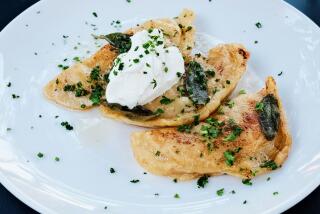Signs of ‘90s Chic Sprout in Once-Rural Santa Clarita : Lifestyles: You can still get a cup of joe at a mom and pop diner. But new European-style coffeehouses attest to changing demographics.
SANTA CLARITA — Are the yuppies coming to Santa Clarita?
Some locals seem to think they’re already here and it’s just a matter of waking up to smell the coffee, or, if you prefer, cafe latte with a sprinkle of nutmeg.
While the community is still a long way from a BMW in every garage and a Cuisinart in every kitchen, the opening in September of the Valencia Town Center shopping mall has made an indelible impression.
For one thing, it has forced mom and pop shops to cope not only with a general economic downturn, but to compete with department stores such as Robinsons-May, J. C. Penney and a host of other retail heavy hitters.
Now, in nearby Newhall, the recent openings of two European-style coffeehouses and a pasta restaurant, complete with neon signs and flashy menus, may portend a trend toward catering to the tastes of a younger, wealthier and more white-collar population.
And if car phones are an emblem of that changing population, David Biondolillo, president of Cellular Mobile Phone Co. of Van Nuys, a PacTel Cellular agent that markets in Santa Clarita, says his company has been adding an average of 500 new phones a month in Santa Clarita in the last year.
“The market in that area is ahead of the norm,” he said. “There’s a lot of commuters, a lot of people that are very mobile, and they’re pretty aware of high-tech products.”
For a rural community that for decades was more at home with onion fields and the remnants of its Western heritage, the appearance of luxury cars with squiggly antennas and hip eateries more typical of West Hollywood or Santa Monica is causing a juxtaposition of old and new that may take a little getting used to.
“We are changing,” said Jerry Reynolds, curator of the Santa Clarita Valley Historical Society. “Until, say, about the ‘60s, the area out here was pretty rural and Western in character. When you went out to eat, you generally knew the person firsthand who owned the place.”
After the 1960s, the Santa Clarita Valley began a transformation from the rural, cowboy, farmer orientation to tract homes and mini-malls.
With pickup trucks and farm vehicles giving way to Infinitis and Volvo station wagons, new restaurants with names such as Fiamma in Canyon Country and Il Terrazzo in Newhall have joined the ranks of Santa Clarita’s 5,000 small businesses. Those eateries are vying for customers with longstanding establishments such as the Saugus Cafe, Tip’s and the Blue Moon.
Among the shops trying to capitalize on the tastes of a growing--and by most accounts changing--population are the Cambridge Coffeehouse, which opened about 18 months ago in the Lyons Plaza on Lyons Avenue in Newhall, and Mitch’s Java ‘n Jazz, which opened in May and is located barely a mile east on Lyons Avenue from the Cambridge.
“There are a lot of people who moved out here from the big city, from Hollywood, Beverly Hills and the Westside,” said Massimo Noja, owner of Il Terrazzo, whose business has been so good that he is planning to open another restaurant-nightclub in the area.
Changing demographics, some residents contend, offer growing opportunities to open businesses that may eventually spell the end of what lured many to the area in the first place.
“It’s sort of becoming another San Fernando Valley,” lamented Reynolds. “The paradox is that people come ‘out here’ to Santa Clarita for its rural atmosphere and immediately demand a bunch of services. There goes the rural atmosphere, and then they wonder what happened to it.”
Jeri Bronstrup, who since 1971 has owned the landmark Way Station Coffee Shop in Newhall’s more traditional east end, says she is not afraid of change, especially since her clientele are loyal, longtime locals who always return for the hearty breakfasts and lunches.
“I don’t feel threatened by the changes,” she said, “but they should try to preserve some of the town’s local flavor and heritage, which means hospitality and warmth in a setting that’s aesthetically pleasing.”
Whether a balance can be struck between tradition and change remains to be seen.
In the meantime, trendy restaurants and shops are likely to grow right along with the area’s burgeoning population of well-heeled, white-collar residents.
More to Read
Sign up for Essential California
The most important California stories and recommendations in your inbox every morning.
You may occasionally receive promotional content from the Los Angeles Times.










